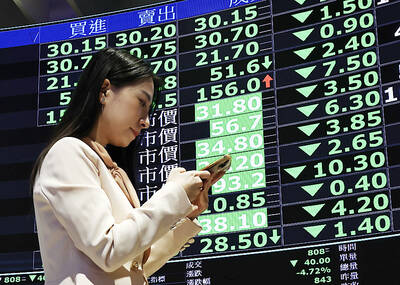Regulators in Taiwan are taking another shot at consolidating a fractured financial system that is scaring off foreign investors.
The nation’s authorities last month made it easier for lenders to merge, part of a long-running campaign to whittle down an industry where assets are so thinly spread that banks struggle to compete with regional rivals.
Government policy in the 1990s created a market where tiny entities carved out niches for themselves, making them fiercely independent.
Taiwan’s 37 banks have a total of US$1.6 trillion in assets between them, about as much as Citigroup Inc.
The crowd is a double-edged sword: Taiwan’s financial sector does not have a single systemically important bank and the risk of a crisis is low, but margins have become so slim that global investors, such as George Soros, have exited over the years.
“Now it’s too difficult for the private sector to consolidate, especially as some small banks still operate quite well and big banks do not want to spend too much money for mergers,” Taiwan Mergers & Acquisitions and Private Equity Council director James Chen (陳民強) said.
“The only thing the government can do is to force state-backed banks to merge, and tackle issues such as cutting staff and opposition from labor unions,” he said.
Assets of Taiwan’s five largest lenders are only about 37 percent of the market’s total commercial banking assets, the third-lowest in the world after Nepal and Bangladesh, World Bank data showed.
In contrast, Singapore stands at 93 percent and China at 53 percent.
“Many Taiwanese banks have recognized that mergers are necessary to expand,” Banking Bureau Deputy Director-General Sherri Chuang (莊琇媛) said. “However, in Taiwanese culture, big shareholders tend not to sell their stakes as even small banks have good asset quality.”
Recognizing large stakeholders’ reluctance to sell, the Financial Supervisory Commission allowed smaller stakeholders to push for consolidation.
In rules that took effect on Nov. 30, the regulator said a bank or holding company that wants to buy another financial institution must have a minimum 10 percent existing stake in its target, lower than the 25 percent required earlier.
“Our regulators have been encouraging mergers, but I will do it only if it’s good for my company,” CTBC Bank Co (中國信託銀行) chairman Tung Chao-chin (童兆勤) said in an interview at Bloomberg’s New Delhi office on Wednesday.
CTBC Bank is Taiwan’s biggest private lender, but has limited opportunities to expand because the nation is small with too many banks, Tung said.
Taiwanese lenders earn average net interest margins of 1.36 percent, lower than the 1.43 percent among peers in Asia’s developed economies and 4.02 percent in the region’s emerging markets, according to data compiled by Bloomberg.
Yet, that could be enough for the players, said Michael On (洪瑞泰), president of Taipei-based Beyond Asset Management Co (晉昂證券投顧).
The Taiwan market is small, and there are too many banks,” On said. “Still, everybody has small bites of rice to feed themselves.”

TARIFFS: The global ‘panic atmosphere remains strong,’ and foreign investors have continued to sell their holdings since the start of the year, the Ministry of Finance said The government yesterday authorized the activation of its NT$500 billion (US$15.15 billion) National Stabilization Fund (NSF) to prop up the local stock market after two days of sharp falls in reaction to US President Donald Trump’s new import tariffs. The Ministry of Finance said in a statement after the market close that the steering committee of the fund had been given the go-ahead to intervene in the market to bolster Taiwanese shares in a time of crisis. The fund has been authorized to use its assets “to carry out market stabilization tasks as appropriate to maintain the stability of Taiwan’s

STEEP DECLINE: Yesterday’s drop was the third-steepest in its history, the steepest being Monday’s drop in the wake of the tariff announcement on Wednesday last week Taiwanese stocks continued their heavy sell-off yesterday, as concerns over US tariffs and unwinding of leveraged bets weighed on the market. The benchmark TAIEX plunged 1,068.19 points, or 5.79 percent, to 17,391.76, notching the biggest drop among Asian peers as it hit a 15-month low. The decline came even after the government on late Tuesday authorized the NT$500 billion (US$15.2 billion) National Stabilization Fund (國安基金) to step in to buoy the market amid investors’ worries over tariffs imposed by US President Donald Trump. Yesterday’s decline was the third-steepest in its history, trailing only the declines of 2,065.87 points on Monday and

TARIFF CONCERNS: The chipmaker cited global uncertainty from US tariffs and a weakening economic outlook, but said its Singapore expansion remains on track Vanguard International Semiconductor Corp (世界先進), a foundry service provider specializing in producing power management and display driver chips, yesterday withdrew its full-year revenue projection of moderate growth for this year, as escalating US tariff tensions raised uncertainty and concern about a potential economic recession. The Hsinchu-based chipmaker in February said revenues this year would grow mildly from last year based on improving supply chain inventory levels and market demand. At the time, it also anticipated gradual quarter revenue growth. However, the US’ sweeping tariff policy has upended the industry’s supply chains and weakened economic prospects for the world economy, it said. “Now

Six years ago, LVMH’s billionaire CEO Bernard Arnault and US President Donald Trump cut the blue ribbon on a factory in rural Texas that would make designer handbags for Louis Vuitton, one of the world’s best-known luxury brands. However, since the high-profile opening, the factory has faced a host of problems limiting production, 11 former Louis Vuitton employees said. The site has consistently ranked among the worst-performing for Louis Vuitton globally, “significantly” underperforming other facilities, said three former Louis Vuitton workers and a senior industry source, who cited internal rankings shared with staff. The plant’s problems — which have not